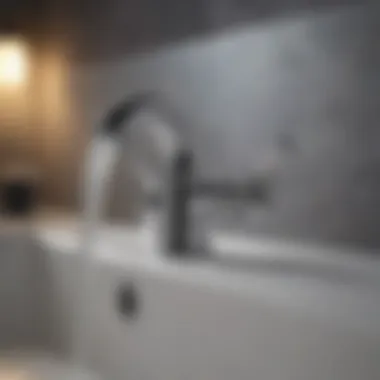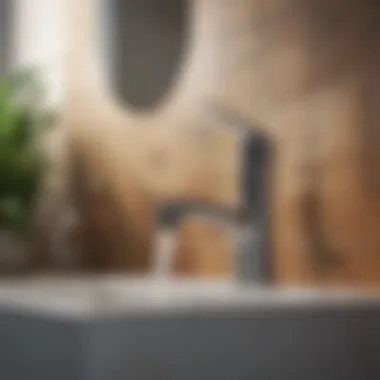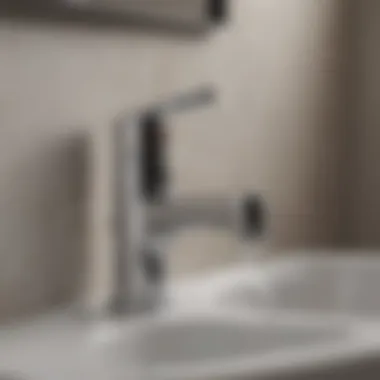Best Sensor Bathroom Faucets: A Comprehensive Guide


Intro
The bathroom faucet is a crucial element in any home, contributing not only to the functionality but also to the overall aesthetic. In recent years, sensor bathroom faucets have gained popularity among homeowners for several reasons. These faucets offer convenience, hygiene, and water efficiency. They operate automatically, activating the water flow upon detecting motion — a beneficial feature, especially in busy households.
This guide will explore the best sensor bathroom faucets available on the market. We will assess their features, advantages, and limitations. Homeowners seeking to improve their bathrooms with stylish and functional designs will find valuable insights in this article. Additionally, we will delve into the installation and maintenance aspects, ensuring a comprehensive understanding of these modern fixtures.
Design Inspirations
Trending Styles
When selecting a sensor bathroom faucet, style plays an important role. Today, there are numerous designs to fit a variety of bathroom decors. Minimalistic designs with clean lines are favored in contemporary spaces. These faucets often feature sleek bodies and smooth finishes, elevating the bathroom's overall look. On the other hand, vintage or classic styles may appeal to those who appreciate traditional aesthetics. Combining modern technology with classic design creates a unique allure.
Consider faucets made of stainless steel, brass, or even matte black finishes, which have become increasingly popular. Each material offers durability and a different visual effect, catering to diverse tastes.
Color Palettes
Color choices are also essential when choosing a faucet. The right color can enhance the ambiance of a bathroom.
- Chrome: Offers a shiny, reflective surface that suits almost any decor.
- Brushed Nickel: Provides a softer finish, reducing fingerprints and water spots.
- Matte Black: Adds a bold statement, perfect for modern or industrial-themed bathrooms.
- Bronze: Provides warmth and a touch of traditional elegance.
Ultimately, the color you choose should harmonize with other elements in your bathroom.
"Selecting the right faucets is not just about functionality; it’s also about making a statement in your home."
Product Recommendations
Top Sensor Bathroom Faucets
When considering specific models to purchase, several stand out in terms of quality, performance, and design. Here are a few noteworthy options:
- Moen Arbor: This faucet is known for its touchless capabilities and elegant design. It features a seamless integration with smart home systems, enhancing functionality further.
- Delta Lahara: Delta's model combines chic style and smart technology, featuring a built-in sensor that reacts quickly to motion.
- Kohler Sensate: This faucet offers a sleek, modern design with a highly responsive motion sensor, making it an excellent choice for those needing efficiency.
Installation Tips
Installing a sensor faucet can be a straightforward process, especially if you follow these steps:
- Turn Off Water Supply: Ensure the water supply is turned off before beginning the installation.
- Remove Existing Faucet: Detach the old faucet and clean the sink area carefully.
- Follow Manufacturer Instructions: Each model may have specific installation steps, so refer to the manual provided.
- Conduct Testing: After installation, turn on the water supply and test the sensor to ensure proper functionality.
Understanding Sensor Faucets
Sensor faucets have become popular fixtures in modern bathrooms. They offer convenience, improved hygiene, and efficient water usage. In this guide, we will explore the essential aspects of sensor faucets, providing critical insights for homeowners and those engaged in home improvement projects.
What is a Sensor Faucet?
A sensor faucet is a type of fixture that operates without the need for physical contact. It utilizes infrared sensors to detect hand movement. When a user places their hands beneath the faucet, the sensor activates the water flow. This design eliminates the need for handles, significantly reducing the risk of spreading germs. Sensor faucets can be powered by batteries or connected directly to the home's electrical system. Their installation can bring a contemporary look to any bathroom while ensuring ease of use.
How Sensor Faucets Work
Sensor faucets function through the use of infrared technology. The sensor detects changes in the environment. When a hand approaches the faucet, the infrared beam is interrupted, triggering the faucet to turn on. Water flow continues as long as the hands are beneath the faucet, and it automatically stops once the hands are removed. Some models also feature adjustable settings for water temperature, which can be pre-set according to user preference. This sensor technology not only enhances convenience but also conserves water by preventing unnecessary flow.


Benefits of Using Sensor Faucets
There are several notable benefits to consider when choosing sensor faucets:
- Hands-Free Operation: This feature reduces the need for physical contact, promoting better hygiene, especially in a shared bathroom.
- Water Conservation: Sensor faucets automatically shut off when not in use. This characteristic can lead to significant savings on water bills.
- Ease of Use: For individuals needing assistance or those with limited mobility, the hands-free functionality simplifies the process of washing hands or rinsing.
- Modern Design: Sensor faucets often boast a sleek and contemporary design, enhancing the overall aesthetic of the bathroom.
- Lower Maintenance: Many models come with self-cleaning mechanisms, making them easier to maintain compared to traditional faucets.
"Sensor faucets are more than just a stylish addition; they embody convenience and sustainability in every drop."
Understanding these aspects of sensor faucets is vital for making an informed choice when upgrading your bathroom fixtures. The combination of convenience, hygiene, and modern design makes them an appealing option for any homeowner.
Key Features to Consider
Understanding the essential features of sensor bathroom faucets is crucial for making an informed purchase. This section will delve into specific elements that enhance functionality, aesthetics, and user experience. Knowing these factors can guide homeowners and DIY enthusiasts toward a more satisfying selection that meets their needs and expectations.
Sensor Technology
Sensor technology represents the backbone of modern faucet design. These devices typically rely on infrared sensing or capacitive touch systems. Infrared sensors detect motion or heat, activating water flow when hands are placed underneath. Capacitive touch faucets use a different mechanism, recognizing the touch on the faucet. This technology not only promotes hygiene but also enhances user convenience. Many high-end models also offer multiple sensing modes, allowing customization for individual preferences.
Design and Aesthetic Appeal
The visual aspect of sensor faucets cannot be overlooked. A well-designed faucet adds to the overall aesthetics of a bathroom. Many brands offer various styles, finishes, and colors that can complement different design themes. From sleek chrome to modern matte black, the options can elevate the space. It's essential to choose a faucet that not only functions well but also aligns with personal taste and interior decor. A harmonious blend of form and function often leads to greater satisfaction.
Water Efficiency Ratings
In an age where environmental concerns are paramount, water efficiency ratings play a significant role in the selection process. Faucets with WaterSense labels, for example, use at least 20% less water than standard models. This means not only lower utility bills but also a reduced environmental impact. Homeowners should pay attention to flow rates and look for options that maintain pressure while conserving water.
Ease of Installation
Installation can be a daunting task for many. Understanding what is involved can save time and frustration. Many sensor faucets come with straightforward installation instructions and all necessary hardware. However, prospective buyers should check if professional installation is recommended for certain models. Some faucets allow for direct replacement of existing fixtures, which may simplify the process substantially.
Durability and Warranty
Durability is a critical consideration as well. High-quality materials such as brass or stainless steel often indicate a longer lifespan. A robust construction can withstand daily use without compromising performance. Additionally, a generous warranty period is a good indicator of the manufacturer's confidence in their product. Many brands provide warranties that cover parts and finish, giving homeowners additional peace of mind regarding their investment.
"Choosing the right features in a faucet is not just about utility; it represents an investment in long-term value for your home."
By understanding these key features, users can make informed decisions that enhance their bathroom experience while addressing practical concerns. A well-chosen sensor faucet can transform daily routines, lead to water savings, and provide a stylish focal point in any bathroom.
Top Sensor Bathroom Faucets
Understanding the significance of sensor bathroom faucets is crucial for homeowners aiming to combine functionality with modern technology. Sensor faucets not only add a contemporary aesthetic to bathrooms but also enhance user experience through convenience and water conservation. This section delves into top choices available today, helping to identify which faucets offer the best features and performance.
Overview of Leading Brands
When considering sensor bathroom faucets, several leading brands stand out in the market. Each offers unique features and finishes designed to meet various consumer needs. Brands such as Moen, Delta, and Kohler have established themselves as leaders due to their innovative designs and user-friendly technology.
- Moen: Known for sophisticated designs and reliable sensor technology, Moen faucets often include updates for better usability.
- Delta: Recognized for innovative features like ToucO technology, Delta faucets provide users with options for both touch and sensor activation.
- Kohler: Offers stylish designs paired with excellent water-efficient technology, Kohler faucets appeal to those seeking both style and functionality.
Each of these brands prioritizes quality and customer satisfaction, making them trustworthy options for homeowners.
Faucet Model Comparisons


When selecting sensor faucets, a comparison of various models is necessary to understand their distinct features and performance metrics. For example:
- Moen Arbor MotionSense: Combines a sleek design with advanced sensors for hands-free operation, perfect for maintaining cleanliness.
- Delta Trinsic Pro: Features ToucO technology allowing users to activate the faucet with just a tap, a practical choice for busy households.
- Kohler Sensate: Boasts a responsive sensor that works effectively in various lighting and temperature conditions, ensuring reliability.
These models can vary in price, installation process, and warranty coverage. Evaluating these aspects helps in making an informed purchase decision.
User Reviews and Ratings
Consumer feedback on sensor bathroom faucets provides valuable insights into everyday usage. Many users appreciate the convenience of hands-free operation, particularly in reducing water wastage.
Common positive reviews include:
- Enhanced hygiene due to touchless features
- Ease of installation and setup
- Sleek aesthetics that modernize bathroom decor
On the other hand, some users have reported issues such as:
- Sensitivity problems where the tap activates unexpectedly
- Sensor range limitations in certain models
- Higher initial cost compared to traditional faucets
These reviews help potential buyers understand both the benefits and pitfalls of various models, guiding them in their decision-making process.
Installation Insights
Understanding the installation process of sensor bathroom faucets is vital for homeowners seeking to enhance their bathroom experience. Proper installation ensures that these faucets function accurately and efficiently, providing both convenience and water conservation. Knowing the critical steps involved can reduce installation errors, which often lead to malfunctions or leaks. In this section, we will outline the preparation needed, tools required, and a clear step-by-step installation process to ease the journey.
Preparation for Installation
Before diving into the installation, it is crucial to prepare adequately. First, start by reading the user manual specific to your selected sensor faucet. Each model may feature unique requirements or particular adjustments needed during setup.
Next, make sure to shut off the water supply to your bathroom. This can usually be done at the source valves under the sink. After that, clear the area under the sink to allow for comfortable working space.
Check the existing plumbing and ensure it is compatible with the new faucet. You may need to purchase additional fittings or adapter kits depending on your current setup. Keeping a towel handy is also advisable to catch any water that spills during the process.
Tools Required
Having the right tools at hand can significantly streamline the installation. Below is a list of essential tools typically needed:
- Adjustable Wrench: Useful for tightening and loosening plumbing fixtures.
- Screwdrivers: Both Phillips and flat-head screwdrivers will be necessary for various screws.
- Plumber’s Tape: Helps prevent leaks by securing threaded connections.
- Basin Wrench: A specialized tool to reach and tighten nuts in tight spaces.
- Towel or Cloth: For drying and cleaning up any water spills during the process.
Step-by-Step Installation Process
With preparation complete and tools on hand, follow these detailed steps to install your sensor bathroom faucet:
- Remove the Old Faucet: If replacing an existing faucet, begin by disconnecting the water supply lines. Use the adjustable wrench for this. Once disconnected, unscrew the mounting nuts under the sink using the basin wrench.
- Clean the Sink Surface: After removing the old faucet, clean the area thoroughly to remove any residue or buildup. A clean surface helps ensure a proper seal with the new installation.
- Attach the Mounting Hardware: Depending on your new sensor faucet, follow the schematic provided in the manual to properly attach the mounting hardware to the sink.
- Connect Water Supply Lines: Reconnect the water supply lines to the sensor faucet. Wrap plumber’s tape around threaded areas to avoid leaks.
- Install Batteries or Connect Power Supply: Many sensor faucets require batteries for operation. Install these as instructed in the manual. If your faucet needs a power connection, ensure it is correctly placed.
- Turn on Water Supply: Once everything is securely in place, turn the water supply back on slowly and check for leaks around the connections.
- Test the Faucet: Finally, test the sensor function by placing your hands within the sensor range to ensure it activates properly.
By following these steps, homeowners can successfully install a sensor faucet and enjoy the benefits of modern technology in their bathrooms.
Maintenance and Troubleshooting
Maintaining sensor bathroom faucets is essential for ensuring their longevity and optimal function. Troubleshooting common problems can also save time and money, making it crucial for homeowners. Proper maintenance not only keeps the faucet looking good but also ensures it operates efficiently. Simple routine checks can prevent bigger issues down the line. This section covers essential practices to keep your sensor faucet in top shape and helps solve issues that may arise.
Routine Maintenance Practices


Routine maintenance of sensor faucets involves straightforward practices that can keep them clean and functional. Here are some key practices:
- Clean the Sensor Area: Over time, dust and grime can accumulate on the sensor. Wipe it gently with a soft cloth to ensure it detects motion efficiently.
- Check for Leaks: Regularly inspect for any signs of leaks around the faucet. If you notice water pooling, it may indicate a seal or cartridge problem.
- Replace Batteries: Many sensor faucets operate on batteries. Check their status periodically and replace them as needed to avoid unexpected failures.
- Inspect the Aerator: The aerator can become clogged over time, affecting water flow. Remove it and clean it if you notice reduced water pressure.
- Flush the System: Periodically running water through the faucet for a few minutes can help clear any sediment that might build up.
Taking these small steps ensures that your sensor faucet remains efficient and reduces the risk of larger issues.
Common Issues and Solutions
Despite the efficiency of sensor faucets, problems can arise from time to time. Understanding these common issues and their solutions can facilitate quicker fixes:
- Faucet Does Not Activate: If the faucet does not turn on when waved at, check the power source and ensure the batteries are not depleted. Clean the sensor area for obstructions.
- Inconsistent Water Flow: If the water flow is sporadic, inspect the aerator for clogs. Cleaning or replacing the aerator can restore normal operation.
- Dripping Faucet: A dripping sensor faucet often signifies a problem with the valve or cartridge. This may require replacement to stop the leak.
- Sensor Sensitivity Issues: If the sensor activates too easily or not at all, adjust the sensitivity levels if the faucet has this option. Refer to the manufacturer's instructions for guidance.
Regular maintenance can prevent most common issues and enhance your user experience.
Addressing these problems promptly ensures that your faucet remains a valuable addition to your bathroom, enhancing convenience and efficiency.
Technological Advancements in Faucet Design
The evolution of sensor bathroom faucets has been driven by significant technological advancements. These innovations are not just a matter of aesthetics; they enhance functionality, efficiency, and user experience. Understanding these advancements helps homeowners make informed choices about their faucet installations by considering how new technologies can cater to their specific needs.
Smart Home Integrations
Smart home integrations have become essential in modern bathroom designs. Many sensor faucets now come with compatibility for smart home systems like Amazon Alexa or Google Assistant. Homeowners can control water flow and temperature with voice commands, enhancing convenience. This integration also allows for personalized settings that remember user preferences, making daily routines smoother.
Moreover, these faucets can provide users with analytics through connected apps. Such data might include water consumption patterns which can foster better water-saving habits. However, it is critical to ensure your home’s ecosystem supports these smart technologies, as not all homes are equipped for such enhancements.
Latest Innovations
Recent innovations in sensor faucet designs also deserve attention. Touchless operation has been refined with enhanced proximity sensors that are more responsive and less prone to false triggers. This innovation means more reliable performance, reducing water wastage. Also notable is the introduction of durability in materials used for these faucets.
Some brands now utilize advanced ceramics and stainless steel finishes that resist tarnishing or scratching. These materials not only improve longevity but also maintain the faucet's visual appeal over time.
Furthermore, modern designs often incorporate LED indicators, which enhance user interaction. These lights can signal when the faucet is in use or alert users of water temperature changes. This feature adds an extra layer of safety, especially in households with children.
"Technological advancements in faucet design improve functionality and provide enhanced user experiences, making home life that much easier."
Overall, embracing these technological advancements ensures that you are not just investing in a faucet but improving the entire bathroom experience. The focus on smart integration and durability reflects wider trends in home design that prioritize efficiency and sustainability.
Culmination
Understanding sensor bathroom faucets is crucial for homeowners looking to enhance convenience and efficiency in their home. This article has covered a broad spectrum of elements surrounding these modern fixtures, emphasizing their growing relevance in today’s world of smart home technology. Sensor faucets offer significant benefits, such as conserving water, reducing the spread of germs, and contributing to a more streamlined aesthetic in the bathroom.
Summarizing Key Takeaways
In summary, sensor bathroom faucets are designed not only for increased convenience but also for better hygiene and water conservation. Here are some key points to remember:
- Hygiene: By minimizing contact with handles, these faucets help decrease the transfer of bacteria.
- Water Efficiency: They often come with features that reduce water wastage, making them environmentally friendly.
- Design Versatility: With various styles available, they can complement any bathroom decor.
- Ease of Use: Ideal for individuals with limited mobility, they provide a user-friendly solution.
The insights gathered from user reviews and comparisons signal that many top models successfully deliver these benefits.
Future of Sensor Bathroom Faucets
As technology continues to evolve, the future of sensor bathroom faucets looks promising. Several trends are emerging:
- Smart Home Integrations: Many sensor faucets are expected to become compatible with smart home systems, allowing users to control them remotely.
- Advanced Sensor Technology: Improved sensor accuracy and responsiveness will likely be the norm, enhancing user experience.
- Sustainability: New designs will undoubtedly focus more on sustainable materials and features, reflecting the growing commitment to environmental responsibility.
These advancements suggest that sensor faucets will become even more efficient and user-friendly. Homeowners must stay informed to choose the best options that fit their needs into this rapidly advancing market.



